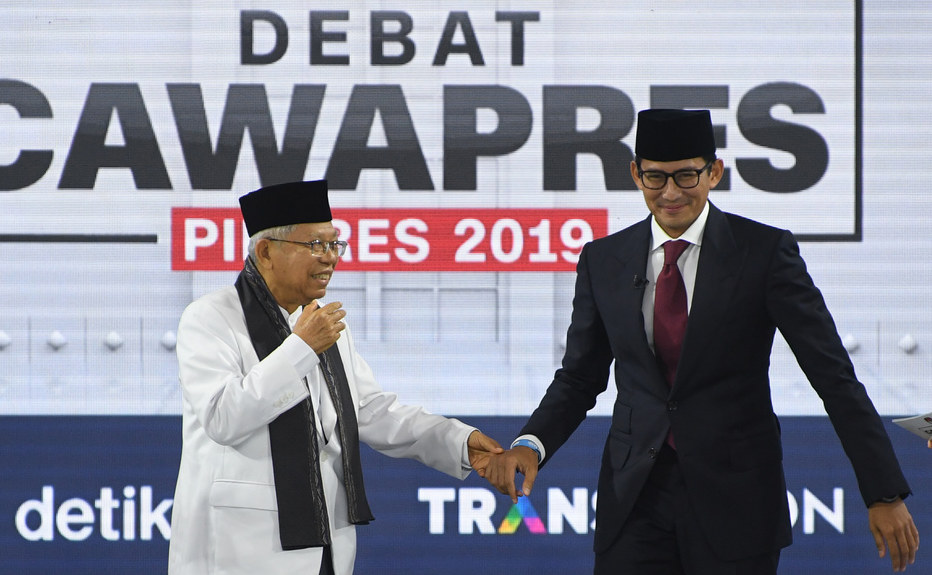JAKARTA, Indonesia (ViaNews) – The third presidential debate was held on Sunday (March.17) at the Sultan Hotel. Unlike the first two, the third debate only involved vice presidential candidates; Ma’ruf Amin (running mate of the incumbent Joko Widodo) and Sandiaga Uno ( vice presidential candidate for Prabowo Subianto).
Amin and Uno come from different backgrounds. The former, who turned 76 on March 11, was head of Indonesia’s Ulema Council (MUI) and is one of the most respected Islamic preachers. While Uno, 49, is a successful businessman and a former deputy governor of Jakarta.
Sunday’s debate focused on issues related to education, health, human resource, social, and culture. Several mainstream media outlets and experts collaborated to check fact from each candidate’s claim. Here they are:
Sandiaga: “Vocational school graduates dominate the number of unemployment, youth unemployment rate (aged 15-24) accounts for 61 percent of the total unemployment rate.”
Fact: According to statistic, the unemployment rate for individuals aged 15-19 reached 26,67 percent in 2018 while the unemployment rate for youths aged 20-24 stood at 16,73 percent, making it 43,4 percent.
Based on educational background, vocational school graduates accounted for 11,24 percent of the unemployment rate in 2018, followed by high school graduates (7.95 percent). The percentage of open unemployment in Indonesia has reached 5 percent since 2013.
Ma’ruf: “Let’s feel grateful that our unemployment rate has reached the lowest, between 5,30 percent- 5,13 percent, the lowest in 20 years.”
Fact: The Statistics Centre Bureau (BPS) data revealed that Indonesia’s unemployment rate in August 2018 was the lowest since 1999. Throughout 1999-2019, the country ’s open unemployment rate has stood at 5,34 percent up to 11,24 percent. The lowest unemployment rate was in 2018 (5,13 percent), and the highest was in 2005 (11,24 percent).
Sandiaga: ”Indonesia’s maternal mortality right still stands at above 300, we are sure that children’s nutrition will improve with a synergized program.”
Fact: Data from the Ministry of Health in 2015 showed that maternal mortality rate reached 305 per 100,000, three-fold from Indonesia’s Millenium Development Goals (MDG) target (102 per 100,000).
Based on this figure, Indonesia comes second as the country with the second highest mortality rate in ASEAN, behind Laos.
Ma’ruf: “ The government has boosted the development of 1,000 startups in four or five years. While it takes 10 years in Iran to create 1,000 startups.”
Fact: The number of startups in Indonesia has so far reached 2,079 based on data from Startup Ranking. Indonesia ranked fourth in terms of the number of startups, behind U.S (46,627), India ( 6,192), Britain (4,909), and Canada (2,485).
Iran ranked 48th with 182 startups. In 2015, the number of startups and startup-potential reached only 52 then rose to 956 in 2018, said Minister of Research, Technology, and Higher Education, Mohamad Nasir.
Sandiaga: “Prabowo-Sandi pair sees micro, small and medium enterprises (UMKM or SMEs) are a solution to job opportunities. The UMKM accounts for 99,9 percent of business units in Indonesia.”
Fact: The number of small business units reaches 93,4 percent, medium enterprise (5,1 percent), and big business unit (1 percent). The Ministry of Cooperatives and SMEs data showed that the percentage of SMEs accounted for 99,9 percent of business units in Indonesia in 2017.
Ma’ruf: “The number of stunted growth rate has dropped 7 percent during the Jokowi-Jusuf Kalla administration.”
Fact: Based on the Ministry of Health data, the rate of stunted growth -malnutrition condition that delays human’s growth- in children under the age of five-hit 30,8 percent in 2018, less than 7 percent decline compared to the 2013 data (37,2 percent).
However, the number of stunting children has risen in the past four years. In 2015, the rate of stunting growth hit 29 percent, and a year later the rate reached 27,5 percent and up again in 2017 (29,6 percent).
What both candidates skipped
Both candidates talked about stunted growth triggered by poor nutrition, but they jumped obesity problems in Indonesia. In January, Dean of Faculty of Medical Science at the University of Indonesia, Dr. dr. Ari Fahrial Syam, Sp.PD-KGEH, MMBcited data from the Ministry of Health that adult obesity rate reached 21,8 percent in 2018, up from 14,8 percent in 2013.
“Obesity is heavily linked with non-communicable diseases such as stroke, coronary heart disease, hypertension, diabetes, and cancer,” added Fahrial Syam.
The debate did not discuss protection for workers, including an internship program that enables fresh graduates to gain opportunities at several companies and work training institutions (LPK).
There are lots of labors who are paid based on intern payment and are left without an employment status, said a researcher at Institute for Development of Economics and Finance (Indef) Ahmad Heri Firdaus.
Some companies abused an internship program by employing interns and by cutting production cost.
In 2016, a state-owned port operator PT Pelindo III violated a manpower regulation on internship. 98 interns worked for years, and they were promised to work for the company, but they were put in the company’s subsidiary after passing the test for permanent employment, said politician from the Indonesian Democratic Party of Struggle (PDI-P) Rieke Diah Pitaloka in 2017.

